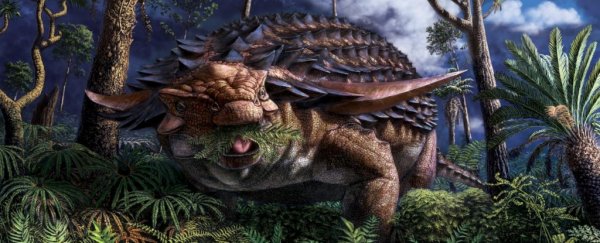The last meal of a huge armour-plated dinosaur has been found 110 million years later, still in its fossilised belly, in what is now northern Alberta.
First described in 2017, this thorny, 1,300-kilogram nodosaur (some 2,800 pounds) unearthed in 2011, is said to contain the best-preserved dinosaur stomach found to date.
After five years of careful work, exposing the dinosaur within the marine rock, the soccer-ball sized mass in tummy has now bestowed us with the first definitive glimpse into what large, plant-eating dinosaurs once munched on all those millennia ago.
"When people see this stunning fossil and are told that we know what its last meal was because its stomach was so well preserved inside the skeleton, it will almost bring the beast back to life for them, providing a glimpse of how the animal actually carried out its daily activities, where it lived, and what its preferred food was," says geologist Jim Basinger from the University of Saskatchewan in Canada.
That's something we've never really known about any herbivorous dinosaur. While this dinosaur represents just one species of one ankylosaur family - known as Borealopelta markmitchelli and without the archetypal 'club' tail of its closest relatives - it could help us better understand dinosaur digestion and physiology, especially since ankylosaurs are found on every continent, including Antarctica.
Some might even remember these dinosaurs from their brief cameo in the animated Land Before Time, in which the lumbering character Kosh does little more than munch on fruit and contentedly belch. In real life, however, some families of ankylosaurs might be pickier and prefer their vegetables.
Just before the Borealopelta in Alberta kicked the bucket and was washed out to sea, perhaps by a flood, scientists say it was nomming on stems, twigs and particular species of fern, while largely ignoring conifer and cycad leaves, which were abundant at the time.
In fact, of all the chewed leaf material found in its guts, 88 percent were deemed fern leaves and just 7 percent were stems and twigs.
"When we examined thin sections of the stomach contents under a microscope, we were shocked to see beautifully preserved and concentrated plant material," says biologist David Greenwood from Brandon University in Canada.
"In marine rocks we almost never see such superb preservation of leaves, including the microscopic, spore-producing sporangia of ferns."
Altogether, the team found 50 types of plant microfossils, including six types of moss or liverwort, a wide variety of ferns, several types of conifers, and two flowering plants.
Among the edible contents, researchers also found gizzard stones - deliberately swallowed rocks animals ingest to help with the digestion of tough materials (crocodiles and seals do this, for example).
But perhaps the most intriguing discovery was the presence of burnt vegetation, which may have been eaten by accident, or potentially on purpose.
"[T]here is considerable charcoal in the stomach from burnt plant fragments, indicating that the animal was browsing in a recently burned area and was taking advantage of a recent fire and the flush of ferns that frequently emerges on a burned landscape," says Greenwood.
"This adaptation to a fire ecology is new information."
If that interpretation is correct, this would represent the earliest evidence of large-bodied herbivores capitalising on the regrowth of vegetation after a fire. And while that might sound incredibly niche, this affects a lot of other life on Earth.
Today, across modern ecosystems, large herbivores are thought to be crucial to the landscapes they occupy. In fact, they are often termed 'keystone' species because they help support the ecosystem at large.
"Like large herbivores alive today, such as moose and deer, and elephants in Africa, these nodosaurs by their feeding would have shaped the vegetation on the landscape, possibly maintaining more open areas by their grazing," explains Greenwood.
The researchers are pretty sure the exceptionally preserved dinosaur died soon after its last meal, but whether or not that meal is indicative of what other herbivorous dinosaurs of its time ate remains unclear.
This is, after all, only a single specimen, and its diet may not reflect the typical or average diet of either the individual or the taxon.
Especially when you consider this dinosaur is thought to have died in late spring to mid-summer, and diet is often tied to seasonal changes and landscape variation in food availability.
"These caveats aside," the authors write, "these data do represent the best available direct evidence of diet in an herbivorous non-avian dinosaur."
The chances of us finding something like this again are extremely rare.
The fossilised stomach is now on display alongside the dinosaur's skeleton at the Royal Tyrrell Museum in Alberta.
The study was published in Royal Society Open Science (link not yet live at time of publishing).
